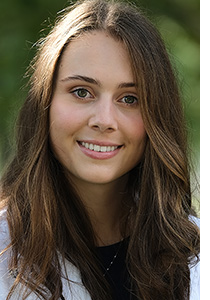 Omotayo Gbadamosi is working to develop a miniature human brain tissue model to advance diagnosis of Alzheimer’s disease.
Omotayo Gbadamosi is working to develop a miniature human brain tissue model to advance diagnosis of Alzheimer’s disease.
Two graduate students are trying to solve medical mysteries by using the latest in animal-free testing technologies.
Omotayo Gbadamosi (BSc 2021) and Jessica Szawara (BSc 2021) each received a Canadian Institute of Health Research Canada Graduate Scholarship - Master’s Program for their health research proposals. They are using a 3D bioprinter to create miniature versions of human organs to emulate human disease in a Petri dish.
 Szawara is researching new ways to assess the effects on human health of inhaled chemicals. She is working in the Canadian Centre for Alternatives to Animal Methods (CCAAM) to develop and validate a 3D-bioprinted human lung tissue model they have dubbed “lung-in-a-dish” to test the toxicity of chemicals in consumer products such as cosmetics and personal care items, household cleaners, and pesticides.
Szawara is researching new ways to assess the effects on human health of inhaled chemicals. She is working in the Canadian Centre for Alternatives to Animal Methods (CCAAM) to develop and validate a 3D-bioprinted human lung tissue model they have dubbed “lung-in-a-dish” to test the toxicity of chemicals in consumer products such as cosmetics and personal care items, household cleaners, and pesticides.
“We are using the latest in 3D tissue bioprinting technology to investigate adverse health effects such as lung fibrosis and carcinogenesis arising from exposure to inhaled chemicals like gases, aerosols, and nanoparticles,” says Szawara.
“To create our lung-in-a-dish, we mix human lung alveolar cells with a ‘bioink’ that acts as a glue to hold the cells together in a defined architecture, much like in real tissue. This tissue can then be kept in culture from days to weeks to study many aspects of lung physiology from genes to organ-level function.”
After they create the lung-in-a-dish model and optimize its function, she says she and her team, led by Charu Chandrasekera, executive director of CCAAM, will expose it to different chemicals to measure acute and chronic biological responses.
“Inhalation is a major exposure route for humans, and we will use our novel tissue model to predict the toxicity potential of various chemicals, to identify chemicals that could cause damage to the human lung. We hope that our model will help reduce and replace animal use in inhalation toxicity testing, which is routinely done in rats and dogs,” says Szawara.
“I never thought I’d be using cutting-edge techniques like 3D tissue bioprinting — it is incredible to have these tools at my disposal and I am thrilled to receive this scholarship to pursue my graduate studies.”
Gbadamosi is using chemistry to help develop early diagnostic tools for Alzheimer’s disease. She is currently pursuing a Master’s degree under the supervision of chemistry and biochemistry professor Drew Marquardt.
Gbadamosi says she feels proud and accomplished to win the award for her thesis that is based on developing a lipid-based delivery targeting agent for magnetic resonance imaging and positron emission tomography scans. She says early Alzheimer’s symptoms can often look like other neurodegenerative disorders but with a specialized target for Alzheimer’s, they can ensure they are detecting it, which will allow for earlier treatment.
“We want to target our specialized lipid vesicles towards beta-amyloid plaques characteristic of Alzheimer’s disease,” says Gbadamosi.
“By improving the diagnostic techniques with this targeted liposome agent, we hope to essentially make the diagnosis earlier, so detect the disease earlier and to start the treatment earlier.”
To validate the functionality of their lipid vesicles, Gbadamosi says they plan to develop a miniature human brain tissue model using the 3D bioprinter at CCAAM.
“We’ll collaborate with CCAAM to build a 3D-bioprinted Alzheimer’s-in-a-dish model replete with a blood-brain barrier to ensure our lipid vesicles can actually cross the blood-brain barrier to target the beta-amyloid plaques in the brain tissue,” says Gbadamosi.
She says they chose to use a non-animal method because there are significant differences in Alzheimer’s disease biology and how compounds cross the blood-brain barrier in laboratory animals compared to humans.
“Using a mixture of human brain cell types, we will create a 3D-bioprinted blood-brain barrier-in-a-dish connected to a miniature Alzheimer’s-in-a-dish brain tissue model,” Gbadamosi says. “This will allow us to have a physiologically relevant model to test our targeting agent.”
—Sara Elliott




